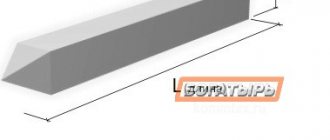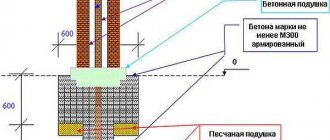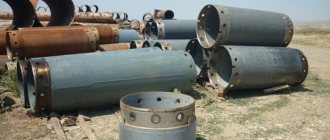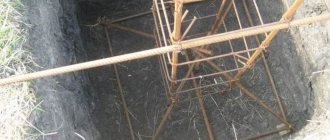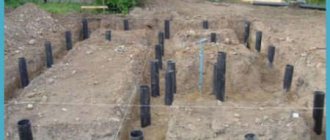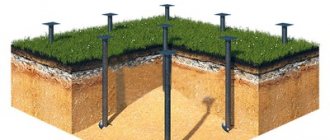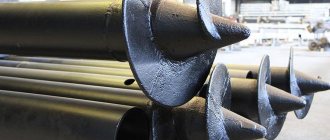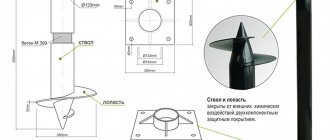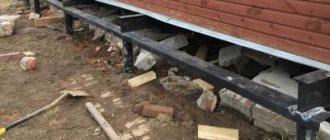Regulations for driving piles - regulatory documentation
Driving reinforced concrete piles - pile field
It should be understood that driving reinforced concrete piles is a labor-intensive process, requires the use of special equipment and is regulated by a number of regulatory documents (GOST, SNiP, TU, Standard Construction Series, instructions and orders). The list of basic standards allows you to understand how difficult this work is.
Detailed information can be gleaned from these documents, but to understand the process, we will provide brief information.
Pile driving scheme
The location of the pile is determined during the development of the project for the future structure. Moreover, each project is unique; its development is preceded by a study of the area (soil, temperature conditions, building density, the presence of underground communications, the possibility of access for equipment, etc.). Material prepared for the website www.moydomik.net
In private and industrial construction, the following pile installation schemes are used:
- pile bush (in private construction under columns, in corners, etc.);
- pile tape (in private construction and for linear structures);
- pile field (in private construction for very large and heavy houses, used mainly in industrial construction for multi-storey buildings).
According to SNiP, piles can be installed according to one of three schemes:
- typical diagram(s) of pile installation. Is the simplest. Suitable for use in sandy and gravelly soils. The use of this scheme involves installing piles in turn - from the first to the last.
Note. A prerequisite for using a row scheme is the presence of uncohesive soils. Otherwise, soil shrinkage may occur.
- sectional diagram of pile installation (b) . It is used when it is necessary to create a pile field when there is dense soil on the site. The specificity of using this scheme is that the piles of one section are driven first, then a row is passed, and the next section is formed. After all sections are arranged, the missing rows are filled in. The use of the scheme eliminates the risk of soil compaction.
- spiral (c) and (d) . Presented in two varieties. The first involves starting work from the middle of the pile bush, the second from its edges. The first method is recommended for working in dense soil, the second - in normal soil. The use of a spiral pattern ensures uniform redistribution of the load on the soil, which subsequently eliminates its movement.
The presence of a pile driving scheme (technological map) allows you to organize the work of equipment and the construction team, thereby minimizing time and money, and all operations are carried out quickly and accurately.
Pile driving scheme (technological map)
Drilled piles
Technology for constructing bored piles
Drilled piles are classified according to the method of construction.
- bored, concreted in wells drilled in silty-clayey soils above the groundwater level without securing the walls of the wells,
- bored, installed in wells drilled in any soil below the groundwater level - with the walls of the wells secured with clay solution or inventory casing pipes,
- drilling injection machines with a diameter of 150-250 mm, arranged by injecting fine-grained concrete mortar into drilled wells,
- drilled piles, constructed by lowering a reinforced concrete pile into a hole and filling the gap with a concrete mixture.
Types of bored piles differ in the method of construction and purpose. Actually, the main type is performed directly at the location by drilling a well, filling it with concrete mortar and reinforcing it with a frame prepared in advance for the entire or partial depth of the well from iron rods and wire.
In difficult soil conditions, quicksand, sandy and soils at the level of underground aquifers, the installation of bored piles (BPS) is carried out under the protection of removable inventory casing pipes or under the protection of a clay (bentonite) solution. It is permissible to leave casing pipes in the ground if groundwater filtration exceeds 200 meters per day. Usually this becomes known from the results of engineering-geological surveys and cheaper retained pipes are used for the construction of the BPS.
BNS device with casing pipes
The diameter of bored piles is determined by calculating the bearing capacity and can be in the range of 300-2000 mm, and the depth is also determined by the level of the load-bearing supporting layer of soil, and can reach 76 m. The purpose of bored piles is to provide a strong foundation for massive buildings and structures due to the large diameter and immersion depth, allowing to reach low-compressible bearing layers and provide a large-area support heel.
In simple soil conditions, a less expensive method of installing bored piles using a continuous hollow auger is used. The essence of the method is that concreting is carried out not using a separate concrete pipe, but directly through the cavity of the drill auger. When the drill reaches the designed depth, concrete is supplied into its cavity under pressure and as it rises, the well is filled with concrete. At the last stage, the reinforcement frame is immersed. After the concrete has set and cured, the pile is ready.
Construction of NPS piles for the foundation of an oil tank
Bored injection piles (BIS) have a special application: strengthening old, dilapidated building foundations, as well as in case of danger of subsidence and soil movement. Drilling with a diameter of 150-250 mm occurs in the immediate vicinity or through the foundation structure. In these cases, LSI reinforcement may not be performed.
Burosecating piles are intended for constructing a solid concrete wall that can serve as a sheet piling fencing for a pit and serve as a foundation and wall for the basement of a building. They are carried out by the method of sequential drilling and concreting of first odd-numbered wells, and then even-numbered ones, ensuring their engagement.
Pile calculation
Calculation of foundation pile racks is performed:
- According to the bearing capacity of the soil under the heel of the pile,
- According to the strength of the pile structure,
- Based on existing horizontal loads.
The sequence of selection, manufacturing, deepening, quality control, testing of piles is regulated by SNiP 2.02.03-85 “Pile foundations”.
Piling technology
Driving reinforced concrete piles involves solving many issues, and choosing a scheme is only one of them. The second important choice is the decision about which technology for driving reinforced concrete piles will be used. Technology determines how piles are driven and what is used to drive piles under the foundation.
The choice of method is based on taking into account three factors:
- the soil . Each technology has its own characteristics, which are better revealed on a certain type of soil. In particular, we are talking about the speed of driving a pile;
- place . Some methods cannot be applied in urban areas, uneven terrain, the presence of underground utilities, etc.;
- pile _ Directly its length, cross-section, durability of the head.
Currently, pile driving technologies have gained recognition, which are listed in the table in descending order of popularity:
| № | Technology | Characteristic | Equipment |
| 1 | Percussion | Dynamic load | Hammer, pile driver |
| 2 | Pressing | Static load | Press |
| 3 | Vibration pressing | Dynamic and static load | Vibrator |
| 4 | Leader well | Dynamic or static load | Preliminary arrangement of the leader well, tools according to the selected technology |
| 5 | Softened soil | Dynamic and static load | Water supply, hydraulic hammer |
| 6 | Electroosmosis | Electricity | The pile acts as a cathode |
A brief overview of all the options shown in the table.
Impact pile driving technology
Considered the most productive. Allows you to drive up to 40 piles in one shift. The bottom line is that to drive the pile, the head is impacted using pile-driving installations (devices).
- hammer for driving piles. The hammer can be diesel, mechanical, steam-air, or hydraulic. Characteristics in the table:
Diesel hammers are considered the most popular. Characteristics in the table:
- pile driver. The driver's task is to correctly install the pile in the ground.
The productivity of the impact method is ensured by the action of two types of energy: impact (transmitted to the pile from the weight of the hammer) and explosive (due to the combustion of the fuel mixture).
The method has limitations due to the fact that the dynamic load applied to the pile head causes strong vibration. This makes it difficult to use the technology in densely populated areas or in dilapidated buildings of cultural or historical value.
How piles are driven using impact technology:
- complete driving of the pile. The impact power is 100% of the equipment power;
- installation of the pile and control of deviation from the vertical axis;
- the pile driver, using a winch, lifts the pile and delivers it to the pile driving installation;
- the pile is slinged and lifted;
- hammer work. The power of the first blows is 1/3 of the power of the equipment;
- failure or reaching the design depth.
Press-in piling technology
It belongs to the category of the most progressive, since the method is based on a static load. The pressing method can be used on any soil under building conditions of any density.
The essence of the technology is that the pile is constantly subject to a vertical load. The force of its impact increases until the design depth is reached or the soil fails.
Vibration-pressure technology for driving piles
A technology that combines the features of the previous two. In the case of its use, a vibratory driver acts on the pile head, which exerts a dynamic load of low amplitude. Thus, the pile vibrates slightly. Due to this, the density of the soil decreases, and the pile gradually sinks to a given depth from the static load. The method is justified for use in non-cohesive soil.
“Leader Well” pile driving technology
The leader drilling technology is an excellent alternative to the others, provided that the work is carried out in dense soil. The peculiarity of the method is to create a well with a diameter of 70% of the diameter of the pile trunk and a depth of 1 meter less than the length of the pile. Reinforced concrete piles will then be driven into the leader hole, which will push the already dense soil apart during the driving process. Due to this, the required strength of the pile installation will be achieved.
The technology is characterized by the absence of noise and vibration (when using a press) and high productivity (when using impact tools).
Pile driving technology “Softened soil”
The essence of the method is to change the characteristics of the soil. It has been noted that soil containing a significant amount of water has less resistance to loads.
Thus, the technology is based on the principle of water erosion (softening). To do this, a nozzle is placed on the heel of the pile, supplying water under pressure. The soil changes its structure and the pile goes in easily. At the same time, the last 1.5-2 meters of the distance the pile should be driven into the ground with a hammer.
Electroosmos pile driving technology
The technology is based on the use of electric current, which is supplied through the pile. The current softens clay soils, and the pile penetrates the soil more easily.
What is a pile foundation
Scheme of the construction of a bored pile foundation.
A pile foundation is a structure that is designed to transfer the entire load from the building standing on it through the piles to the ground. Such a house foundation is erected in cases where incompressible layers of soil are deep. This happens on weak peat or swampy soils. Any foundation must rest on a layer of solid soil to withstand the pressure of the weight of the house. The larger the area of the building's base, the less pressure it exerts on the ground.
The largest area is the foundation on slab-type driven piles. The entire area of the building rests on the ground. The ribbon structure has a significant area. A pile structure rests on solid ground with the ends of the piles, so its support area is somewhat smaller than that of a slab and strip structure.
Piles for the foundation can be hanging. Their lower ends do not rest against a solid layer of soil. The frictional force formed between the soil and the surfaces of the supports holds them and ensures stability. Another type is stand piles. They rest their lower end on a hard layer of soil. Such foundation piles are the most reliable and stable.
When designing a foundation on piles, the weight of the entire house is calculated and divided by the number of racks. The result is the load on each support. Piles under the foundation are usually driven with the load that they will have to withstand. When they rest and do not go deep into the soil, this is a sign that a solid layer has been reached that can withstand the given load. It can lie at different depths and consist of different rocks.
It will not be possible to drive reinforced concrete piles under the foundation manually; you need a pneumatic hammer. Therefore, independent construction of a foundation on driven reinforced concrete piles is not possible. Driven supports for the foundation are installed under the walls of the future building, in the corners and at the intersections of the walls. The number and distance between them depends on the total weight of the building. The pile heads are cut at the same height. The building will be erected on them in the future.
The process of driving reinforced concrete piles - stages
If we consider the complete process of driving piles, it can be described in several successive stages:
- delivery. Reinforced concrete piles are quite heavy products that need to be brought, unloaded and placed on the construction site in such a way as to minimize their movement during the driving process;
- development of a work plan. Taking into account the location of the pile and the work project, a route for the movement of the pile driver and hammer along the site is developed;
- site preparation. In particular: garbage removal, tree removal, leveling (if required), etc. In some cases, a pit is dug before installing the piles;
- marking the installation site of piles;
- marking the pile. The markings are applied with bright paint in increments of 1000 mm. The presence of marks allows you to control the degree and speed of penetration of the pile into the soil;
- equipment setup;
- driving piles using the selected technology.
Note. During the installation of each pile, the level of its deviation from the vertical axis is monitored. Permissible deviations are contained in the document (“Quality control of the construction of foundations from driven and bored piles”).
Features of fence installation
Sheet hanging material, designed for installation on driven piles, is attached to square or round posts. This type of support is designed specifically for this type of pipe. The special shape and size are ideal for quick installation of columns. Watch the video on how to mount a fence on screw piles.
Since there is no need to install additional fastening structures, the process of installing a fence on driven piles is somewhat simplified and has characteristic features.
The installation process is slightly different for square and round pipes. To secure vertical square pipes into the nest of driven piles you will need:
- square pipe measuring 40 or 50 mm, depending on the size of the socket in the pile head;
- screwdriver or electric drill;
- level, plumb line and marking cable;
- engraving screws;
- mark;
- a metal drill corresponding to the cross-section of a self-tapping screw.
Installation of a fence on piles
In the side face of the nesting head of the column there are special holes, according to which the base of the pipe should be marked and drilled passages for the self-tapping screw. This must be done because usually the self-tapping screw is not strong enough to pass through the dense metal of the pipe. In addition, before installation, holes should be made for attaching horizontal guides if a solid sheet material is selected for hanging.
To install round pipes into the corresponding sockets of round heads, you just need to insert the pipe into the socket and secure the sliding mechanism with a special locking ring, which is included with the pile. The most convenient way to do this is with a special pipe hammer, which applies uniform pressure on the surface of the ring. Regardless of the type, driven fence piles provide good stability of the structure, and all rumors about the unreliability of such a foundation are the result of poorly performed work.
Pile failure during driving
The immersion depth of the pile is determined by the calculation method and is reflected in the project. However, in practice, the pile may not reach the calculated depth or may go below the specified level.
The case when a pile no longer sinks as a result of the force applied to it is called “soil failure” or “pile failure”.
The failure point can be calculated using the formula:
To make sure that the pile has definitely reached “failure”, a series of blows are performed (with impact technology) or the time during which force is applied to the pile head is increased (with pressing technology). These impacts, which do not lead to the advancement of the pile into the soil, are called “pledge”.
There is another term that describes the case when a pile does not sink due to overheating - “false failure”. In this case, work is suspended for a time sufficient to cool the tip of the pile located in the ground.
Note. If there is no failure to achieve the design depth, the piles are driven in after a four-day break. If failure is not achieved, you should look for the reasons and change the driving procedure in order to prevent a decrease in the design bearing capacity of a particular pile.
What are the advantages of bored piles
Not every area on the ground can support the foundation of an average building. Therefore, some of the residents of future buildings use some tricks to build the foundation.
The most profitable and most in demand in our time is considered to be a design that uses bored piles.
They remarkably strengthen the foundation, have a high load-bearing capacity, and are also much cheaper than tape and monolithic analogues.
To strengthen the foundation for a medium-sized house, fifty tongue and groove sheets will be enough for you, since one of them can support about one and a half tons of weight.
Driving process
They are located slightly lower than the soil freezing level and waterproofing is used in the form of two layers of roofing felt. It is necessary to prevent the piles from being pushed out in winter. In addition, the waterproofing layer will significantly reduce the force of pressure on the piles.
This method of constructing a foundation has the following advantages:
- There is no danger of dynamic impacts on nearby buildings;
- Excellent for relief, sloping and unstable soils;
- The surrounding landscape will not suffer from this type of foundation;
- Any convenient site will become suitable for construction with a foundation made in this way;
- Possibility to build any types of buildings (brick, log, frame);
- In terms of cost savings - the cheapest;
- Construction can be completed in a week.
Agree that few foundations can boast so many advantages and advantages.
Do-it-yourself pile driving
Despite the fact that driving reinforced concrete piles generally requires the use of specialized equipment, it is quite possible to implement it yourself. Let's look at how to drive piles manually, with the caveat that the pile has dimensions acceptable for work.
Do-it-yourself installation of piles is carried out using impact technology. To organize a dynamic load, you need to assemble a tripod, hang several concrete blocks on it (serve as a counterweight) and a hammer. The hammer is raised by cables to the maximum height and fixed. Once the pile is installed, the hammer is released and the pile is driven into the soil. The procedure will be repeated until the required depth is achieved.
Design and types of pile drivers, operating technology
Machines for driving piles have different dimensions for different lengths of piles and their depth. Accordingly, they have different power and functional features. They also differ in the drive of the driving apparatus.
The pile-driving installation itself can be located on the basis of several types of machines, it can be removable or not.
Pile driving methods
The pile drivers lift the pile, with the help of 1-2 people and sometimes special equipment - a bulldozer, install it in the desired design position and the driving process begins, in which 3 main technologies are used:
- Impact method
, in which pile driving occurs under periodic (20-40 per minute) blows of a pile driver hammer.
Driving a pile with a diesel hammer
Before driving a pile, a special tip is put on it, which prevents the destruction of the pile under the influence of hammer blows.
- Vibration method
, in which piles are immersed in the ground due to vibrations. In general, these are the same blows, only at a low frequency.
I recommend: How to install a flat roof
- Pressing in piles
. A modern method of installing piles, providing high speed and virtually silent operation without vibrations compared to the driving method. Pressing is carried out by pile pressing machines using their own weight and additional loads.
